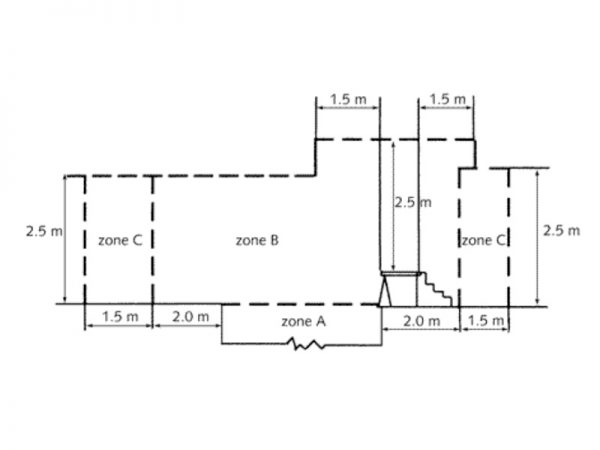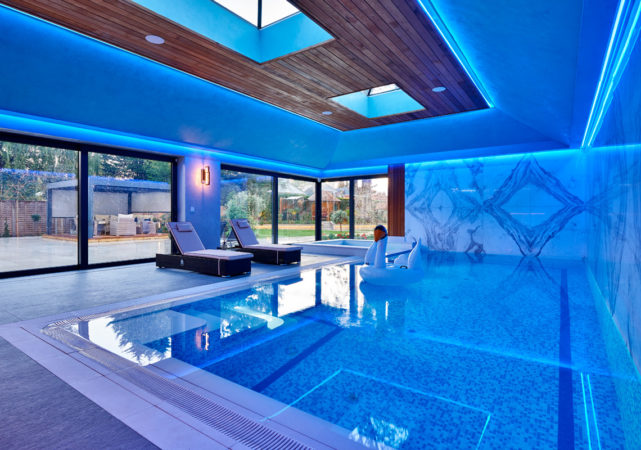Good swimming pool lighting can really help give a swimming pool the wow factor, whether it’s an indoor or outdoor pool, in a public space or private home. Read on for 5 swimming pool lighting tips from experienced lighting design consultants.

Maintenance of swimming pool lights
Maintenance should be a key consideration of the lighting design for a swimming pool. So how are you going to access lights to clean and change the bulbs? This is why a lot of people choose to light externally from each side. Light fixtures located directly above water are clearly difficult to access. Using fittings that incorporate a ‘chip on board’ (COB) LED light source will certainly help reduce maintenance requirements as they offer a very long lamp life (over 50,000 hours in some cases).
Recessed LED fixtures within pools are a great way to create a fantastic glow from the pool at night, however the control gear (drivers / transformers) for these LED fittings still need to be accessible from the pump house or nearby.
Fibre optic lighting is another good solution. With fibre optic the light source is located remotely far away from the water and the light travels along long fibres so it a very safe solution for lighting in and around pools.
IP rating/SELV of swimming pool lights
We all know electricity and water do not mix; so any applications where electricity is in close proximity to water, particular care needs to be taken and of course the regulations and British standards need to be followed. SELV (Safe Extra Low voltage) lighting or fibre optic lighting should be utilised in and around swimming pools. The 17th edition of the British Standards state clear boundaries for the specification of equipment.
It is important that these are followed as they ensure if the integrity of a light fitting is compromised, it will not cause a hazard to people around it. The guidelines split a swimming pool space into clearly defined zones. And fittings are required to be of a certain standard for each zone.

If fixtures are located within a pool, submerged underwater, then they need to be IP68, fully submersible for prolonged periods of time, and we recommend high quality stainless steel to last. There are relatively few quality manufacturers who design fixtures to this standard. The flex from the fixture to the power source should terminate outside of the water whilst ensuring that voltage drop is not an issue.
How chlorine affects swimming pool lights
Lux / illuminance levels of swimming pool lights - how bright should they be?
For public pools there are very specific guidelines for determining correct average maintained illuminance levels (measure in Lux). CIBSE SLL lighting guide 4 (Sports) is a good resource; levels increase depending on the level of competition, from an Olympic televised pool to your local leisure centre. Typically most pools require between 200-750lux.
For private residential swimming pools and Spa retreats, the level of light is much less important; you want to avoid giving a flat wash of light with level uniformity. It’s much more important to create a relaxing, comfortable, fun and even dramatic environment.

Reflectance and glare of swimming pool lights
The surface of a swimming pool can act as a giant mirror reflecting the ceiling and lighting. Also in pools users are often lying on their back, so there’s an increase risk of glare caused by light fittings. Careful placement of luminaires and understanding key viewing angles of the pool, avoids these issues. Also lighting from within the pool will help reduce the mirror effect.
The Lighting Design Studio is a London-based international lighting consultancy that has been lighting not only swimming pools, but residential and commercial spaces since 2011.
If you have any queries about swimming pool lighting, or have a project that you need help with then please do get in touch.